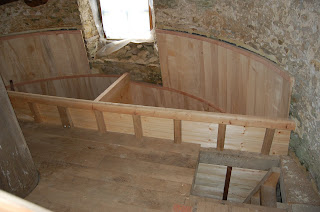The newly-refurbished boulter on the stone floor is looking splendid, seen here with the cover on...
and with the cover off.
Also looking good is the bin floor; the sycamore panelling has been trimmed neatly with douglas fir strips, and capping strips added to the bin dividers. Consider the 'i's dotted and the 't's well and truly crossed. One day I'll buy a fish eye lens to show these views properly!
Up on the dust floor, the very poorly wallower has been removed from the main shaft, for major reconstructive surgery back at the workshop. This freed up some room around the shaft, so the last area of flooring could be joisted and decked out. My knees will never be the same again! The 'hole' in the floor is to allow the sack hoist drum to bear against the underside of the wallower, thus giving a friction drive. Much of the mechanism for the sack hoist was absent, so we are extrapolating from what we have seen on the stone floor (where there are similar mechanisms to drive the boulter).
Unfortunately, over the years, water seems to have found its way into the main shaft, probably where it was seeping through the rotten wallower. So, there is a rot pocket in the main shaft which will need repairing. We need a very solid structure here, against which we can wedge the wallower in place.
And finally, the curved stairs to the dust floor are finished, complete with handrail. Luxury, compared to a tied-on ladder.








